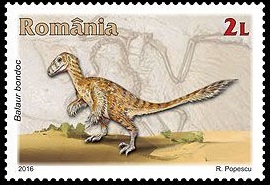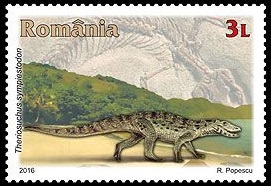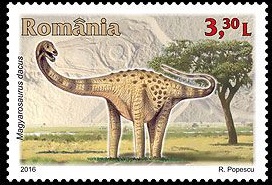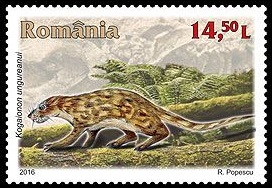Romania 2016 "Prehistoric animals"
| <prev | back to index | next> |
| Issue Date | 22.01.2016 |
| ID | Michel: 7027-7030; Scott: 5753-5756; Stanley Gibbons: ; Yvert et Tellier: 59745977- ; Category: pR |
| Design | Stamps design: Razvan Popescu. Artwork: Jakub Kowalski for the Transylvanian Dinosaur Museum. |
| Stamps in set | 4 |
| Value |
RON 2.00 - Balaur bondoc RON 3.00 - Theriosuchus sympiestodon RON 3.30 - Magyarosaurus dacus RON 14.50 - Kogaionon ungureanui |
| Size (width x height) | stamps: 48 mm x33 mm Mini-Sheet: 134 x 134 mm, Mini-Sheet (limited edition): 112 x 148 mm, |
| Layout | Sheets of 32 stamps, Mini-Sheets of 5 + label, Mini-Sheet (limited edition) of 4 |
| Products | FDC x1, MS x4, Souvenir Booklet x1, MC x4 |
| Paper | Chromo-gummed paper - UK origin |
| Perforation | 13.25 x 13.25 |
| Print Technique | Offset, 4 colours |
| Printed by | Fabrica de timbre |
| Quantity | 6400 stamp sets in sheets, 6600 sets in Mini sheets, FDC: 470, Maxi Cards: 200, Souvenir Booklet, with limited edition Mini-Sheets: 245 |
| Issuing Authority | SC Romfilatelia SA |
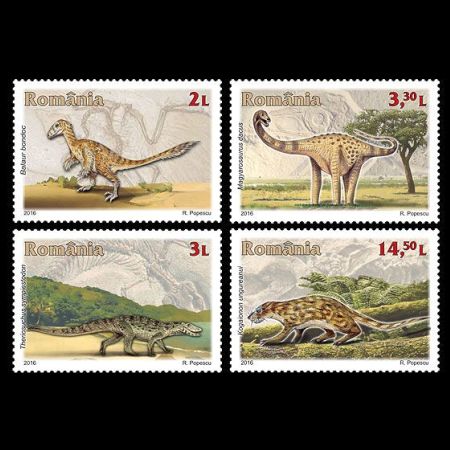
On January 22nd, 2016, Post Authority of Romania issued the set of 4 stamps depicting some prehistoric animals who lived 70 million years ago, on the territory that is today Tara Hategului.
The following text was published on the website of Romfilatelia in 2005
The territory that is today Tara Hategului was part of a tropical island in the Tethys Ocean, the ocean separating Eurasia from Gondwana, following the fragmentation of the single continent, Pangaea. The island was populated by an exotic association of prehistoric animals, whose remains are today preserved in the rocks of the Tara Hategului. Here were discovered numerous sites with bones of crocodiles, turtles, mammals, flying reptiles, birds and a large number of fossils of dwarf dinosaurs, herbivores and carnivores, unique in the world, together with nests of dinosaur eggs.
Lack of permanent links of the island with the mainland areas determined, in time, the adaptation of the dinosaurs's size to a small space and smaller quantities of food. The dinosaurs that lived here were smaller than those on the mainland, being known in the scientific world as the dwarf dinosaurs of Transylvania. This phenomenon has been termed as insular dwarfism and could also be observed in other types of animals.
Dinosaurs Geopark - Tara Hategului is an area of research, education and sustainable development, committed to preserving the geological, natural and cultural heritage, and strengthening the identity of local communities. It is a natural park and a UNESCO Global Geopark, managed by the University of Bucharest, and member of the European Geoparks Network and the Global Geoparks Network supported by UNESCO.
The postage stamp issue presents prehistoric animals whose fossils were discovered in Tara Hategului and which are important elements in building a Museum of Transylvanian Dinosaurs and the Geopark's development.
This predator had a powerful torso and very solid hind limbs with two sickle claws, while the forelimbs were more elongated and equipped with only two functional fingers.
Despite its small stature, Balaur was not an island dwarf; his relatives from other continents (Asia, North America) were not much larger in size. Island adaptations of this animal sooner affected the construction of his body and consequently his way of life. The massiveness of his body compared with that of his close relative, the Velociraptor, suggests that Balaur preferred stability during walking at the expense of speed - something clearly advisable, given the irregular terrain, sometimes rocky, of the island that it populated.
Theriosuchus sympiestodon depicted on the postage stamp with the face value of 3L, was a primitive crocodile that lived in Hateg about 70 million years ago. Theriosuchus was a real "living fossil" - it was part of a family whose members had already disappeared in other parts of Europe millions of years earlier.
Though related to current representatives of crocodilians such as the crocodile or the alligator, Theriosuchus had a vastly different way of life from them. Crocodilians today are usually semi-aquatic, large size carnivores, and relatively slow moving, hunting by ambush at the water's edge, while Theriosuchus was small (about 1 meter long), partly terrestrial and probably largely omnivorous - as proven by his small, triangular and flattened teeth.
Magyarosaurus dacus, illustrated on the postage stamp with the face value of 3.30L, was a herbivorous dinosaur with a length of 7 meters and a height of 3 - 4 meters, one of the largest prehistoric animals from the Hateg area. It weighed 800 - 900 kg. It walked on four legs, having a very long neck and tail.
This species is one of the best examples of insular dwarfism identified worldwide. For a long time, it was considered plausible that specimens of Magyarosaurus, discovered in the Hateg Basin, belonged to young individuals, still growing. Recently, bone microstructure studies showed, however, that these small specimens (their relatives in France reached 10 - 12 meters in length) were fully - at least developed adults, showing that Magyarosaurus was indeed a "dwarf" according to dinosaur standards.
Kogaionon ungureanui is illustrated on the postage stamp with the face value of 14.50L. It was a small mammal, described and known only in Tara Hategului. From it, a complete skull was kept, which is extremely rare in mammals during the Late Cretaceous.
Kogaionon is part of a group of mammals extinct for over 35 million years, called multituberculates. These mammals, related only distantly to today's mammals (marsupials and placental), were characterized by a highly specialized dentition, their molars' surface being covered by a large number of small protrusions - "tubercles".
The morphology of the teeth suggests that Kogaionon was omnivorous, unlike other mammals of the Late Cretaceous, which were mostly insectivorous or carnivorous.
Hatzegopteryx thambema depicted on the cachet of the FDC was a pterosaurs - a flying reptile - of gigantic proportions. Discovered fragments show a wingspan of 12 meters and a skull length of over 1 meter, it being considered one of the greatest flying organisms of all time. The association of a flying giant dinosaur with the dwarf dinosaurs of Hateg Island may seem a paradox - explained by the fact that by its aerial way of life, Hatzegopteryx was not strictly constrained to the scope of this island and could easily reach other food sources, unlike the terrestrial dinosaurs.
Products and associated philatelic items
| FDC | First-Day-of-Issue Postmark | |
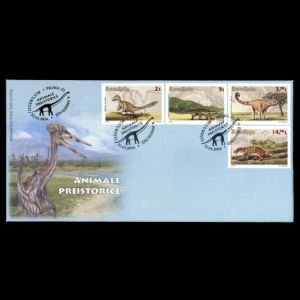 |
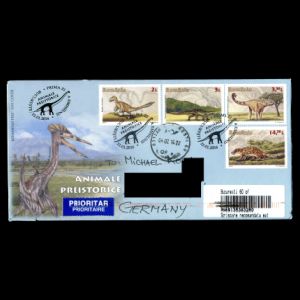 |
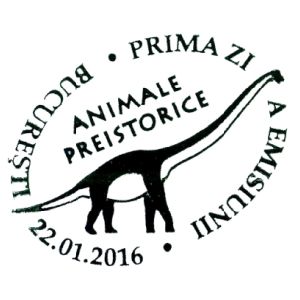 |
| Mini-Sheets | Mini-Sheet (limited edition) | Maxi Cards |
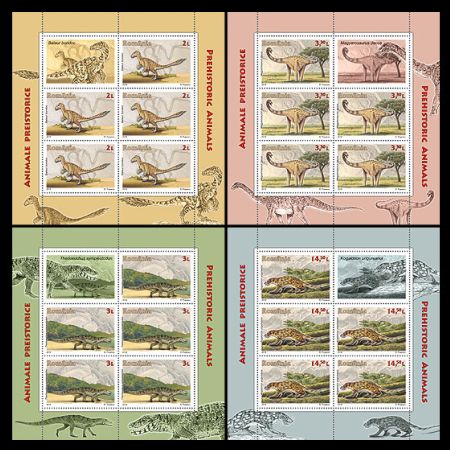 |
 |
 |
| This numbered Mini-Sheet was sold in the limited edition booklet with detailed description of the prehistoric animals and FDC. | ||

|
| Amazon: USA, UK, DE |

|
References
- Technical details and short description:
Romfilatelia (Romanian version contains more details), colnect.
Acknowledgements:
Many thanks to Dr. Peter Voice from Department of Geological and Environmental Sciences, Western Michigan University, for reviewing the draft page.| <prev | back to index | next> |
